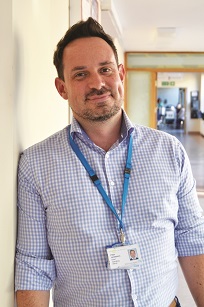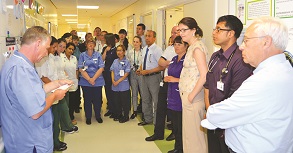Feature / Incremental gains
With greater efficiency and
productivity vital to the NHS, a Sussex trust has embraced continuous improvement and Lean methodologies in its day-to-day work.

The NHS is no stranger to the continuous improvement (Kaizen) and Lean techniques first developed in the Japanese car industry. Hospitals have used the methodologies to, for example, reorganise storage cupboards so their contents can be accessed quickly or to give an at-a-glance picture of patients as they move from preparation to surgery to recovery.
These can improve the patient experience, engage and empower staff and, sometimes, save money. But in many trusts they are isolated projects, often dismissed as too small to have a lasting impact.
Western Sussex Hospitals NHS Foundation Trust, 
however, has taken the mantra of continuous improvement and applied it across the organisation. The improvement programme, known as Patient first, sets out the trust’s long-term approach to transforming and delivering its hospital services, explains executive director of strategy and delivery Peter Landstrom (right). Be it small steps or complex change, he says, the programme is a continuous process of improvement within existing processes and pathways, leading to measurable improvements for patients and staff.
He adds that it empowers frontline staff to make improvements themselves – by providing the training, tools and freedom to work out where the opportunities are – and gives them the skills and support to make change happen, and then making it sustainable. A Kaizen office is one element of Patient first, equipping staff with the right skills (see box).
‘It’s based on Lean methodologies and continuing improvement of processes and pathways across the whole organisation,’ says Mr Landstrom. ‘It’s less about isolated individual improvement projects and more about the way we do business – improving the quality of our care, safety and financial performance, among other things.’
With the overarching Patient first programme embedded in the trust’s strategy, day to day it focuses on what it calls True North – how services can be delivered to improve patient outcomes and experience.
This is supported by a number of objectives in four areas: sustainability; staff; quality improvement; and systems and partnership.
While Mr Landstrom accepts that a lot of hospitals will focus on similar goals, he adds: ‘What we feel is unique is how we have oriented them to the concept of True North goals and how we are putting all our improvement effort into achieving those goals. It’s about how we build the capabilities of our staff and their awareness and ability to use improvement methods, expert support, leadership behaviour and how we as a senior team work.
‘As a senior team we talk about removing the rocks from the shoes of our staff so their efforts are going into improving patient care and delivery of services.’
True North includes a number of measures of success:
- Excellent patient experience – assessed through the friends and family test
- Sustainability – balancing the books so it can continue to invest in services
- Quality improvement – achieving 99% harm-free care (the trust is in the top 20% in the country for lowest hospital standardised mortality ratio)
- Staff engagement – listening to, training and supporting staff to work on continuous improvement, assessed through the annual staff survey
- Systems and partnership – streamlining processes to improve patient flow and meet A&E and referral to treatment waiting time targets.
Each measure is further broken down into breakthrough objectives.
For example, in sustainability the trust aims for break-even or better. This objective is not linked to the trust’s control total and is seen as a long-term aim. The trust’s control total in 2016/17 was a surplus of £17m, taking into account sustainability and transformation funding. Though it failed to achieve the control total – largely due to missing its financial target in Q4, which in turn limited its access to STF – it still made a retained surplus of £8.8m.
‘The biggest improvement on this breakthrough objective was reducing agency spend,’ Mr Landstrom says. ‘Like a lot of areas, we have a lot of workforce challenges. Reducing agency spending was our key breakthrough, looking at areas like market management and recruitment. And in the last financial year, we reduced our agency spending from £23m to £18m – that’s a real saving of £5m.’
Lean techniques – getting to the causes of the spending with the help of staff – played a role in reducing agency spend.
‘We asked what are the drivers of this spending and out of that came the question
of how we can better manage specialling – which is one of the biggest challenges. And because of that it became a quality driver, focusing on the care we give our patients, rather than a purely financial one.’
In quality, the breakthrough objective in 99% harm-free care in 2016/17 was reducing falls. Mr Landstrom explains that the data clearly showed falls as a priority. The risks and causes of falls in hospital were stratified and this led to the development of a bespoke solution for each ward. Also, after each fall, staff on a ward will look at where it occurred, check the environment and discuss the patient’s condition, frailty, and medication to determine the cause and address it.
‘This is part of the power of our continuous improvement approach because it helps us understand the clinical requirements,’ says Mr Landstrom. ‘We’ve had a 30% reduction in falls over the past year. This is huge for us as it has saved bed days and avoided harm to patients.’
The trust has improved its delayed discharge record in intensive care – an area for improvement noted in its Care Quality Commission report. It used a Lean problem-solving approach to bring the right people together to review in detail the entire discharge process from ITU to the wards.
After an in-depth analysis, they identified the top three interventions that would have high impact and not be too difficult to implement. This included agreeing a new standard for board rounds and infection control guidance.
According to Mr Landstrom, in  2016/17 Western Sussex was one of the few trusts to achieve the CQUIN payment for a 30% reduction in critical care bed days occupied by patients who are ready for discharge to a ward.
2016/17 Western Sussex was one of the few trusts to achieve the CQUIN payment for a 30% reduction in critical care bed days occupied by patients who are ready for discharge to a ward.
‘This obviously had an impact in terms of patient experience, resources deployed in critical care and patient flow. There was some financial benefit as we received the CQUIN payment and it also links back to our True North quality improvement – we have seen better flow through critical care so the overall lengths of stay have improved.’
The trust has rolled out the training to wards and clinical areas to give staff the tools to carry out their own improvement work. There has been a lot of work on patient flow.
For example, on one of its general medical wards – Castle Ward – staff have been trying to speed up the discharge process by focusing on the timeliness and accuracy of TTOs (to take out medication).
‘TTOs are an age-old problem,’ says Mr Landstrom. ‘We did a focused piece of work around it and one of the underlying issues was the accuracy of TTOs on the ward. A baseline exercise showed that the accuracy was 50%.’
The Lean work led to a change in the system for issuing TTOs on the ward. Previously, junior doctors would write them up and the prescriptions would be sent to the pharmacy to be checked. Even if the TTOs are accurate, there are some inefficiencies and delays in the system. Under the new system, doctors and pharmacists sit together to write up the TTOs, speeding up the process and making it more accurate.
‘The accuracy went from 50% to 95% and the average time taken for TTOs to be verified and issued went down from three hours to 10 minutes,’ Mr Landstrom adds. ‘It was about using the improvement techniques to critically think through the underlying issues. We have been able to turn the dial on this with no extra resource. We have rejigged the way the teams work – they are doing what they were already doing but in a smarter way.’
The flow improvement work resulted in a 25% reduction in average lengths of stay on the ward, with knock-on improvements in patient experience, bed availability and savings.
Staff engagement
Mr Landstrom says Patient  first has increased staff satisfaction – they want to be engaged with the improvement work. For example, band 2 healthcare assistants working on one ward suggested and drove forward a project on improving bed turnaround. They were frustrated that, say, a bed could be ready for a patient to be admitted from A&E but it could take a long time for the patient to arrive.
first has increased staff satisfaction – they want to be engaged with the improvement work. For example, band 2 healthcare assistants working on one ward suggested and drove forward a project on improving bed turnaround. They were frustrated that, say, a bed could be ready for a patient to be admitted from A&E but it could take a long time for the patient to arrive.
The HCAs came up with a two-part solution. ‘First, they standardised the way beds should be turned over, setting out what needs to be in place to make a bed available – how to make a bed and clean it so it meets infection control standards. This is also great for training and induction of new staff,’ he says.
Second, they now go and collect patients when their bed is ready. ‘This has all sorts of benefits, including greater continuity of care and a large reduction in the downtime of beds. We saved about 50%. This had a huge impact on the delayed flow to wards. The ward now manages its own admissions and there is a better patient experience.
‘Small improvements can make a big difference. It’s about getting into simple improvements and then, through continuous improvement, you start seeing bigger results.’
Mr Landstrom says the support of the organisation’s leadership is vital to the success of Patient first. ‘We have senior leaders – the board and executives – who understand this is worthwhile. In challenging times, it could be easy for this work to be thrown off course, but we are holding true to the belief that this is the way we go about meeting some of these challenges,’ he says. ‘You need to be a relatively stable organisation. We are a medium-sized trust with two acute sites serving a big geographical area, but we are stable and this enables us to take the extra step forward.’
Individually, the issues addressed by Lean and other improvement techniques can seem to have little impact, but, as Western Sussex shows, rolling them out trust-wide can improve staff morale and patient experience, avoid costs and even attract income.
Improvement programme
Western Sussex’s Patient first work and the staff engagement it has created played a key role in the Care Quality Commission awarding the trust an overall ‘outstanding’ rating last year. The trust has trained hundreds of staff in Lean and other improvement techniques and 20 wards have been involved in the improvement process.
‘Doing more of the same was not going to continue to drive improvement,’ says the trust’s executive director of strategy and delivery Peter Landstrom. ‘We needed a different strategy to see us through to the future. There are good examples in the US and emerging examples in UK vanguards, doing elements of what we are doing, but they are not quite as comprehensive as we are.’
He adds: ‘We feel we are unique because we are not doing everything in isolation. It’s part of our whole system approach and that’s been the take-home message for trusts that have come to see how we do things.’ Visitors have included US value expert Don Berwick (pictured above, far right, attending an improvement huddle).
The trust’s Kaizen improvement hub oversees training and the sharing of learning across the trust. Managers and clinicians are seconded from other parts of the trust, with support from KPMG.
Russ Jewell, a director at KPMG’s healthcare consulting practice, who has a clinical background, says consultants tend to be called in when something goes wrong, savings are needed or there are quality issues. But such crisis points are often symptoms of a deeper malaise.
‘It can be frustrating as a consultant that you rarely get to address the root causes. So we took a step back and asked what we would do if we had two years with an organisation? What would we put in place in terms of capabilities and infrastructure?’
KPMG was able to do this at Western Sussex. The trust was not at crisis point but had realised pressures in the NHS meant it had to change. The consultants worked at three levels – the executive; the front line, giving people the skills to drive improvement at trust or ward level; and the Kaizen office, which ties these levels together.
Mr Jewell agrees with Mr Landstrom that pulling together the trust’s improvement efforts through the Kaizen team and ensuring continuous improvement is part of the trust’s DNA are crucial.
Mr Jewell admits to being a convert to Lean, having experienced traditional, project-based Lean schemes. ‘I was a massive Lean sceptic,’ he says. ‘You do some improvement work, but when the focus moves on to another project it slips back to the way it was. So people concluded Lean doesn’t really work in the NHS.
‘But what we are doing is very different – it’s about sustainability around the management system and changing the way the organisation runs itself.’
Related content
We are excited to bring you a fun packed Eastern Branch Conference in 2025 over three days.
This event is for those that will benefit from an overview of costing in the NHS or those new to costing and will cover why we cost and the processes.